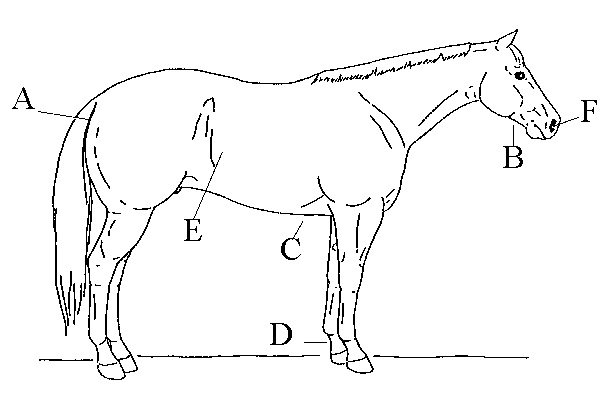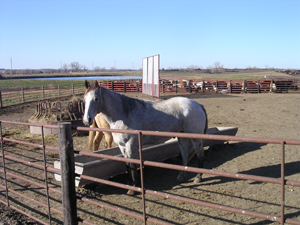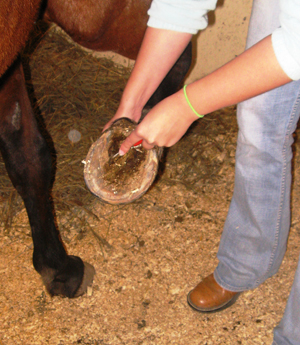G2039
Tips for New Horse Owners
This NebGuide provides basic information on housing, feeding, and health care of horses for new horse owners.
Kathleen P. Anderson, Extension Horse Specialist
- Where Will the Horse Live?
- How Do You Feed Your Horse?
- What Routine Care Should You Give Your Horse?
- Which Health Practices Does Your Horse Need?
Pleasure horses for personal and recreational use represent the largest category of horse ownership in the United States, with about 2 million people owning such horses. Whether a person already owns a horse or is considering the initial purchase of a horse, this NebGuide will help answer many questions asked by new horse owners.
Where Will the Horse Live?
|
Horses can be kept at a person’s own place or boarded at a commercial stable. Keeping a horse on a person’s acreage provides more management control, saves time and expenses, and can reduce the risk of injuries and disease. Most importantly, it allows fuller enjoyment and greater learning experiences. However, it also requires more management, knowledge, and time. Remember, horses must be cared for daily.
Is pasture necessary for a horse? No. Current nutritional knowledge indicates a horse may be well-fed without pasture (Figure 1). However, pasture has several advantages. It is the natural feed for horses, reduces the cost of feeding, provides exercise, and saves labor. Horses usually are healthier when kept outside on pasture.
Two acres of pasture usually are recommended per mature horse. One acre of pasture can provide adequate grazing but requires more management and equipment. Horses will quickly overgraze this small area. Therefore, a combination of pasture and small lot or barn would be needed to minimize overgrazing. The horse could be confined to the lot or barn and only allowed to graze for specified times, thus reducing damage to the small pasture.
What facilities and land does a horse need? Horses need shelter and an exercise area. A typical box stall is usually 10 feet by 12 feet, or 100 to 144 square feet. The minimum exercise area should be 50 feet by 100 feet or 5,000 square feet (about one-eighth acre), but 100 feet by 200 feet or 20,000 square feet (about one-half acre) is better. So, a horse requires one-fourth to one-half acre without pasture. With pasture, one needs about one and one-half acres to two and one-half acres. A three-sided run-in shed or shelter belt of mature trees is adequate housing for horses on pasture.
Boarding arrangements vary from pasture only to full board, where the horse is stabled, exercised, fed, groomed, and even tacked up for the owner to ride. Board often includes a stall and an exercise area with or without various other services such as feeding, mucking stalls, etc.
A horse owner selecting a boarding facility should consider management, body condition of current boarded horses, availability, condition of facilities, and health requirements. Management personnel, as well as those doing the daily routines, should be professional, experienced, and reliable. Thin or excessively obese horses indicate poor management or a lack of horse knowledge. A quick walk through the barn and areas where horses are housed should give a general impression of the overall health and quality of care.
Run-down facilities in need of repair usually result in more injuries and give an indication of the quality of care. However, a quality stable need not be overly fancy, just safe and well maintained. Certain facilities and amenities such as an exercise/practice arena, pasture, trails, lessons, training, tack shop, etc., may be important to some individuals. A boarding stable should have a contract that requires a current negative Coggins test and health certificate. These requirements will protect your horse as well as those already at the boarding stable.
How Do You Feed Your Horse?
Horses are simple-stomach herbivores who need some forage, either as pasture and/or hay in their diet. When pasture is limited or not available, horses must be fed good-quality hay.
To best feed a horse, its weight needs to be known. Feeding guidelines are based on pounds of feed per 100 pounds of body weight. The average stock-type mature horses weigh 1,200 pounds. Lighter breeds such as Arabians and Morgans will weigh about 1,000 pounds. If you cannot actually weigh your horse, use a weight-tape available from feed stores to estimate your horse’s weight. Another method is to use a body weight equation, which only requires a measuring tape:
| W | = | HG2 X BL |
330 |
||
| W | = | Weight in pounds |
| HG | = | Heart girth in inches |
| BL | = | Body length in inches |
For more detailed information on taking the measurements and using the formula, see Basics of Feeding Horses: Feeding Management (G1781).
A mature pleasure horse should be fed 1.5 to 2 pounds of good-quality grass hay, such as prairie, brome, or orchardgrass, per 100 pounds of body weight. Therefore, a 1,200-pound horse should eat 21 to 24 pounds of grass hay daily. If a legume hay such as alfalfa is used, feed 1.5 to 1.6 pounds per 100 pounds. A 1,200-pound horse should be fed 18 to 21 pounds of good quality legume hay per day. If a horse is not ridden often, hay may be the only feed needed. However, feeding 1-2 pounds of grain daily allows the owner to inspect the horse and also makes the horse easier to catch.
Normally, a pleasure horse in good body condition that is getting good quality hay or pasture needs little grain. A maximum of 4-6 pounds of grain fed daily along with hay or pasture is sufficient. A thin horse, ridden a lot, needs more grain, 6 to 8 pounds per day, until it improves in body condition. A pleasure horse should have a body condition score of 5 to 7 on a scale of 1 to 9. A horse is considered in good body condition when its ribs cannot be seen but can be felt by applying slight pressure over the ribs. More detailed information on body condition scoring of horses can be found in the NebGuide Basics of Feeding Horses: Feeding Management (G1781).
In addition to good quality hay and a small amount of grain, pleasure horses should have fresh, clean water available at all times except when they are hot from being ridden or exercised. If a horse is on pasture or on an all-hay diet, trace mineralized salt should always be available.
If you participate in strenuous horse activities, it may be necessary to provide additional feed. Activities only slightly more strenuous than pleasure riding may require an increase in hay only. Feeding 25 percent more hay and 1 to 2 extra pounds of grain may be sufficient. However, more energy (grain) will be needed if the activity is moderate to intense. As grain is increased, the amount of hay fed may be reduced. However, horses require a minimum of 1 pound of hay per 100 pounds of body weight.
What Routine Care Should You Give Your Horse?
|
Stabled horses naturally require more time and management than those on pasture. When stalled, they should be fed twice daily, watered, and their stalls cleaned daily. All horses need certain routine management, such as care of teeth and hooves.
Horses require routine annual dental care, especially as they become older. Fall is the preferred time to check a horse’s teeth before winter feeding of coarse hays. Sharp edges on the horse’s molars can be removed or “floated,” which makes it easier for the horse to chew feed and results in more efficient feed use. Any time a horse holds its head to one side to chew, feed falls out of its mouth, and/or whole grains appear in the manure, you should have its teeth checked by a veterinarian.
Horse’s hooves should be cleaned before and after every ride (Figure 2). Depending on the type of riding, where ridden, surface ridden, and overall hoof condition, shoes may be necessary. Most horses need to have their hooves trimmed, or shoes reset every six to eight weeks, even in winter. Never turn horses out on pasture for extended periods with shoes on, unless you routinely inspect them. A loose shoe can severely injure a horse.
Grooming also is necessary before and after every ride, as well as in the spring, to remove the long winter haircoat before riding. Proper grooming helps develop a bond between owner and horse and should never be neglected or rushed.
Another important management task is “mucking-out” a horse’s stall daily. Mucking-out a stall is the removal of all solid waste material and wet, soiled bedding. Clean bedding equal to that removed or enough to provide a comfortable, absorbent bed should be added daily. Many products can be used as bedding, including sawdust, shavings, or straw. Cost, availability, storage, and labor are factors in selecting the best bedding for your situation. Bedding material should absorb urine; be comfortable, encouraging a horse to lie down; be dust-free; and provide a secure footing and a pleasant odor.
Which Health Practices Does Your Horse Need?
Horses are exposed to a number of internal parasites that may result in inefficient feed utilization and could debilitate a horse. The current recommended deworming program is to alternate deworming products annually. In other words, one product is used over the course of a year followed by use of a different classification (mebendazole, organosphosphate, avermectine, etc.) of dewormers the next year. One exception is that the horse should be dewormed for bots each fall and spring. Check labels to determine the types of parasites for which the dewormer is effective against. If bots are not listed, use a different deworming product in the fall and spring. Most dewormers must be used every 60 days. Moxidectin can be used every 80 days. It is best to consult with a veterinarian when setting up a deworming program.
Based upon research, paste deworming is as effective as tube deworming. When paste deworming, first rinse out the horse’s mouth. Use a large (2-ounce) plastic syringe full of water two or three times to remove feed from your horse’s mouth. Place your left thumb in the back of the horse’s lips, then insert the end of the paste tube alongside your thumb so the paste can be gently squirted on the back of the horse’s tongue. You can massage the horse’s throat and/or raise its head to encourage it to swallow. Dosages for deworming are based on a horse's body weight.
As with deworming, horses should be routinely vaccinated for certain common horse diseases, especially tetanus, Eastern and Western encephalomyelitis, and influenza. Initially, two immunizations are given about four weeks apart. Afterward, an annual booster is required.
When a new horse is purchased, it should get these vaccinations if the vaccination history is unknown. It is advisable to re-immunize your horse for influenza every 60 to 90 days if it co-mingles with others or travels to events with other horses. Your veterinarian may recommend additional vaccinations, depending upon disease problems in your area.
All horse owners should become familiar with the normal vital signs of a horse and be able to take them. A normal horse at rest should have a temperature of 100°F, which is taken rectally (Figure 3). The pulse or heart rate of a horse at rest should be 30-40 beats per minute and can be taken one of three places (Figure 3). The pulse can be found with a stethoscope under the heart girth, or with fingers placed below the horse’s jaw or on the inside of the pastern joint. The respiration rate is taken by watching either as the horse inhales and exhales (one respiration) through its nostril, or the rise and fall of the flank (Figure 3). Resting respiration rate should be between 8 to 16 breaths per minute. Being able to monitor these vital signs aids in determining if the horse is sick or healthy.
For more information on these and other horse topics, contact your extension office or veterinarian, or visit the national eXtension website at http://extension.org/horses.
 |
| A = Temperature B, C, or D = Heart Rate E or F = Repiration Rate |
| Figure 3. Locations for monitoring vital signs. |
This publication has been peer reviewed.
Visit the University of Nebraska–Lincoln Extension Publications Web site for more publications.
Index: Horses
Management
Issued November 2010

